When it comes to Gujarati cuisine, one dish that sits at the top of my favorites list is the Thepla. It is nothing but a Gujarati style flatbread, with many variants. Here, I have shared the recipe of Mooli Thepla – a tasty one, with whole wheat flour (atta), white radish (mooli) and spices. It is light, quick to make and also nutritious. You can make these for breakfast, as a snack, or even pack in a tiffin or lunch box. It also remains soft. So, you can have it any time of the day.
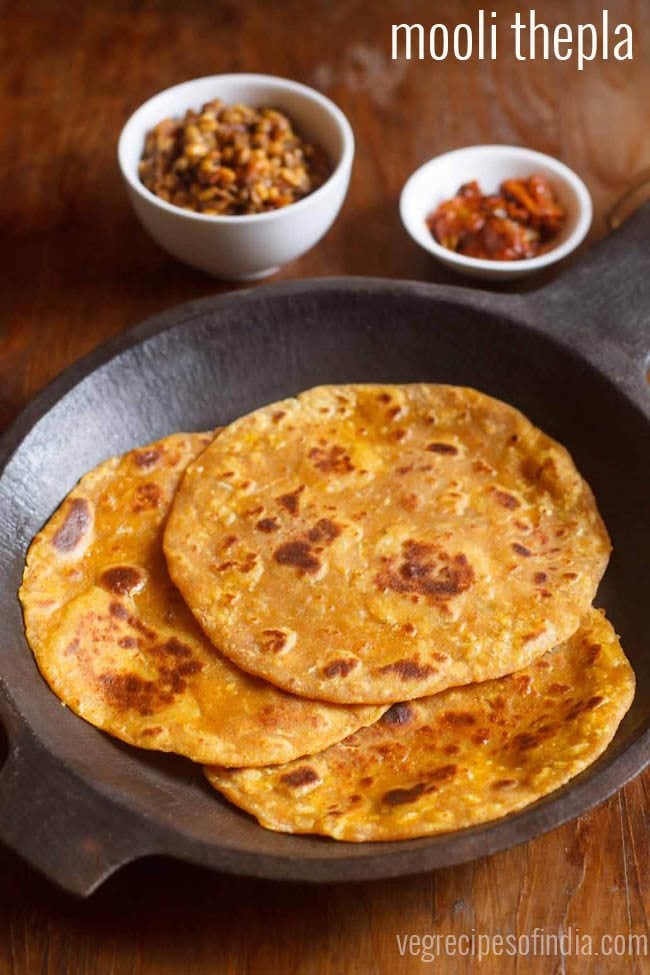
About Mooli Thepla
Theplas are traditional, classic spiced flat breads from the Gujarati cuisine. There are many variants of it. Here, I share one of my personal favorites, which is the Mooli Thepla that is made with the fresh and tender radish roots.
Though most of the time we prefer Methi Thepla at home, on occasions, I do make the Mooli Thepla as well as other versions of this savory flatbread with different vegetables like that of Lauki Thepla, a variation made with lauki or bottle gourd.
However, my recipe for Mooli Thepla is very different from the classic methi thepla, as I have not made these radish ones with millet flours. These whole wheat flour flatbreads taste good and you cannot really make out that they have radish in them. So, it is great to make these for your loved ones, especially fussy kids.
Table of Contents
Besides radish and whole wheat flour, other ingredients that go in this Gujarati special Mooli Thepla are gram flour (besan), curd (yogurt), ginger-green chili paste, oil or ghee (clarified butter) and some ground spices. These are turmeric powder, red chili powder, cumin powder and coriander powder. All your basic ones.
Mostly Mooli Thepla are served with Mango Pickle, curd, Aam Chunda or any vegetable dish. We love to have these warm flatbreads with a hot cup of Masala Chai or Ginger Tea.
The wholesome Mooli Thepla come as a big rescue, especially if you are a working person, as they can be made quickly. The addition of radish makes these flatbreads heartier and healthier. We usually love to make these during winters.
You can either roast the Mooli Thepla with oil or ghee spread or brushed on them. Adding gram flour or besan imparts a nice nutty flavor in these Gujarati style radish flatbreads. We like the flavor of besan, but if you don’t prefer, then you can also skip it.
With tender white radish, I also make the quintessential Mooli Paratha. But let me tell you that a Mooli Paratha is made differently and is not the same as the Mooli Thepla. Also, both are different in terms of flavor too.
One significant difference is that in the radish paratha, the rolled dough is stuffed with a layer of grated radish, while in a thepla, the grated radish is added to the flour along with other ingredients and then kneaded into a dough.
These varying preparation methods give a unique taste and texture to both these types of Indian flatbreads.
How to make Mooli Thepla
Preparation
1. Rinse, peel and grate the radish (mooli) in a bowl or plate. Grate about ¾ to 1 cup mooli. Use radish that is fresh, tender and juicy.
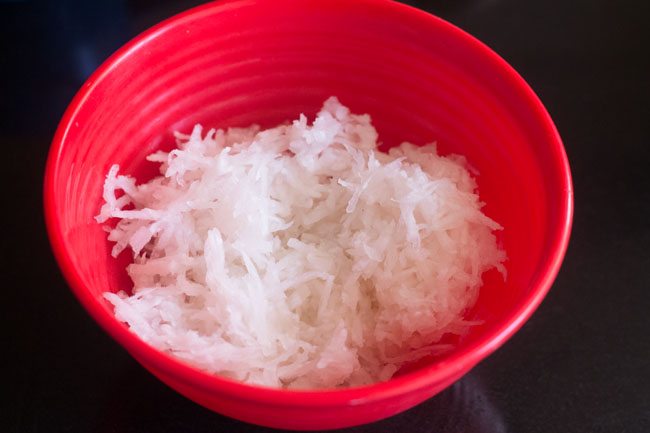
2. Measure and keep all the ingredients ready.
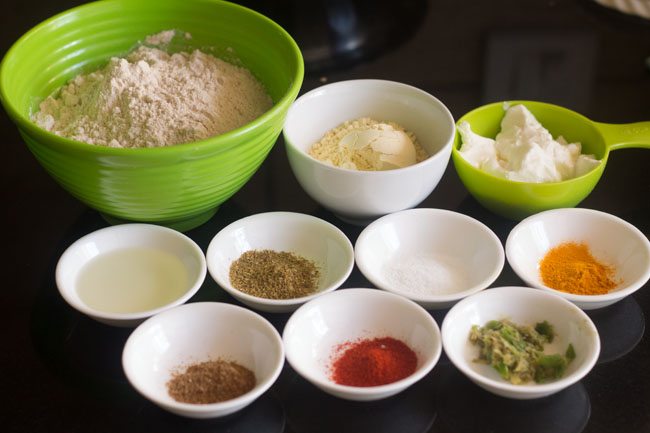
Make Rradish Mixture
3. Add grated mooli in a big plate or bowl. Also, add the following ingredients listed below:
- ½ teaspoon coriander powder
- ½ teaspoon cumin powder
- ½ teaspoon red chili powder
- ¼ teaspoon turmeric powder
- 1 teaspoon ginger-green chili paste
- ¾ teaspoon salt or as required
Note: You can vary the quantity of spices as per your taste preferences.
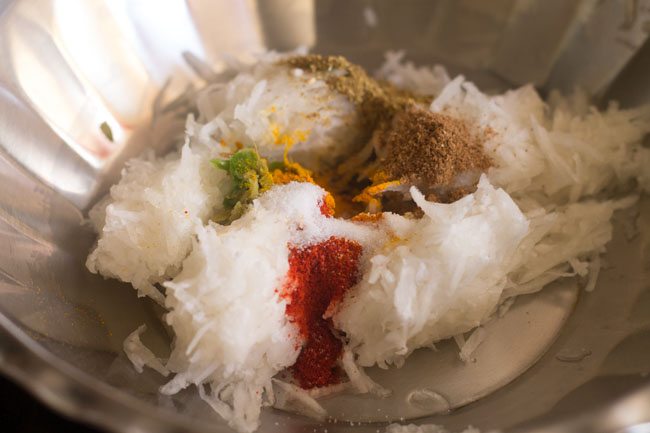
4. Mix the spice powders very well with a spoon.
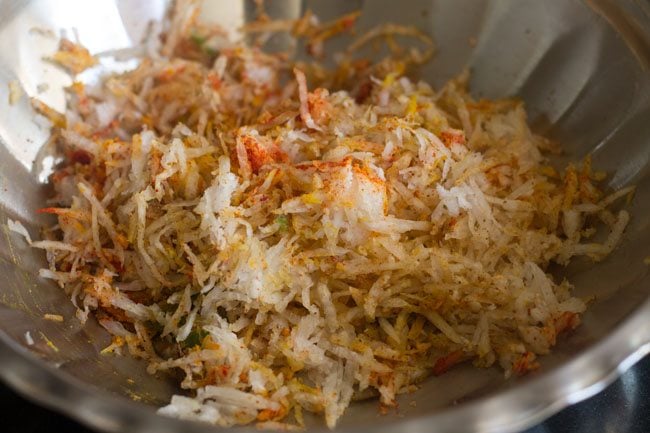
5. Cover and set aside for 5 minutes. Soon, radish will release its juices.
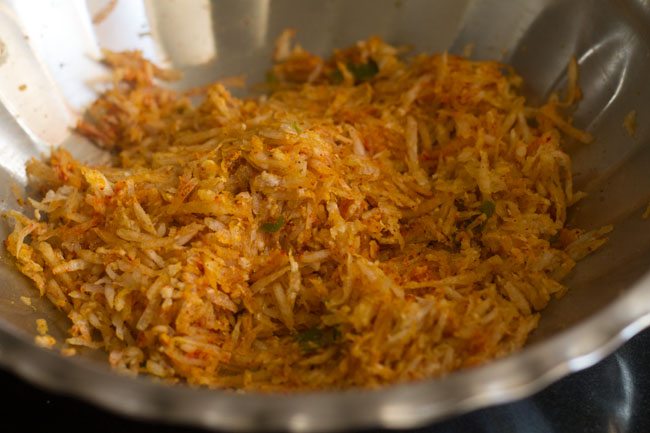
Make Dough
6. Next, add 1.5 cups whole wheat flour (atta) to the radish mixture.
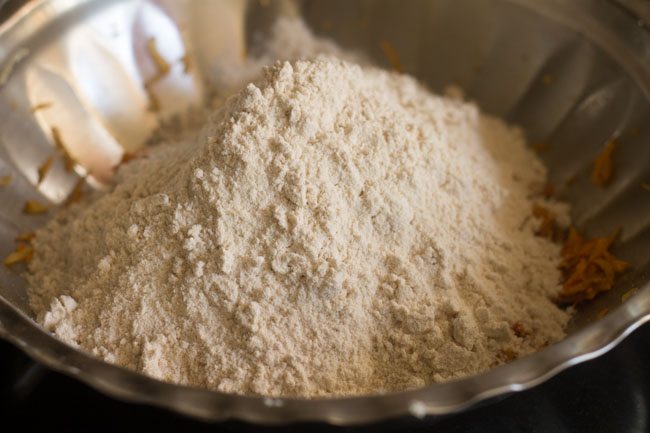
7. Add 3 tablespoons of gram flour (besan) or chickpea flour.
If you are not using gram flour, then skip this step.
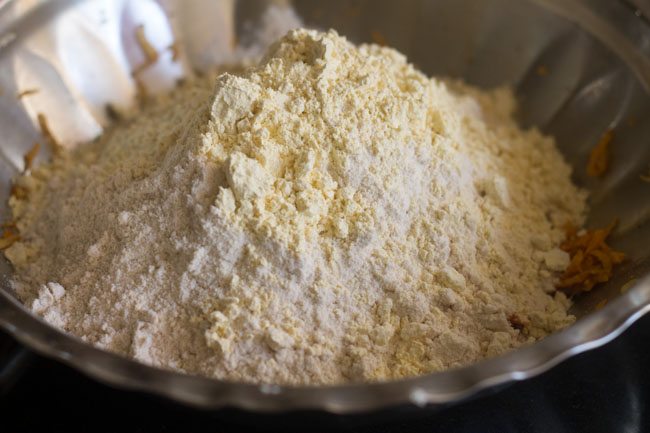
8. Mix well with your fingertips.
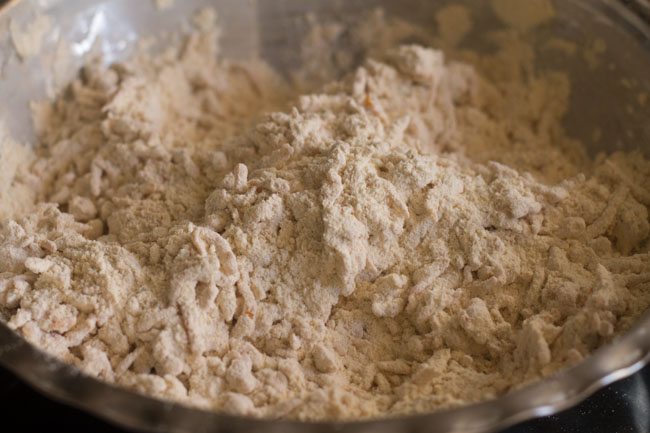
9. Add 1 to 2 tablespoons yogurt (curd) and 1 tablespoon oil.
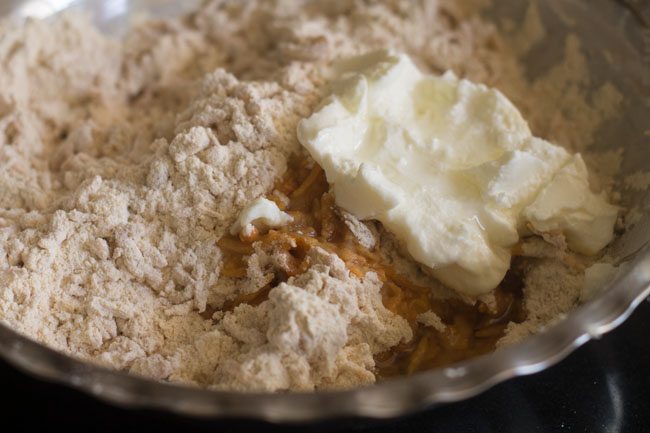
10. Mix well and begin to knead a smooth soft dough.
If the dough becomes sticky, add some more whole wheat flour. If the dough looks dry or hard, add 1 to 2 tablespoons more curd and knead again.
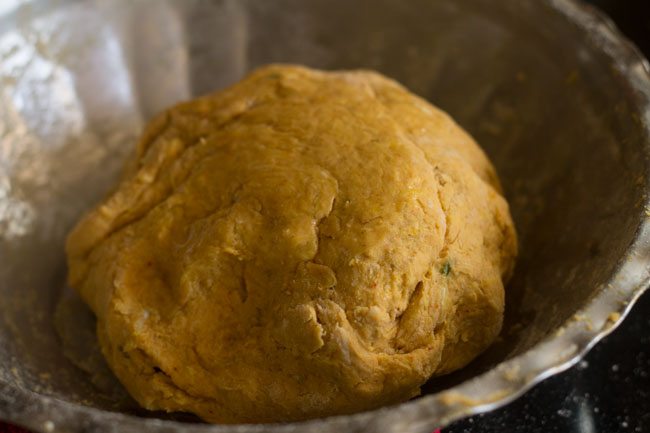
11. Cover the dough with a plate, linen cloth or cotton napkin. Allow the dough to rest for 5 to 6 minutes and then again lightly knead it for a minute.
Make medium-sized balls from the dough. Cover with a cloth or lid and keep aside.
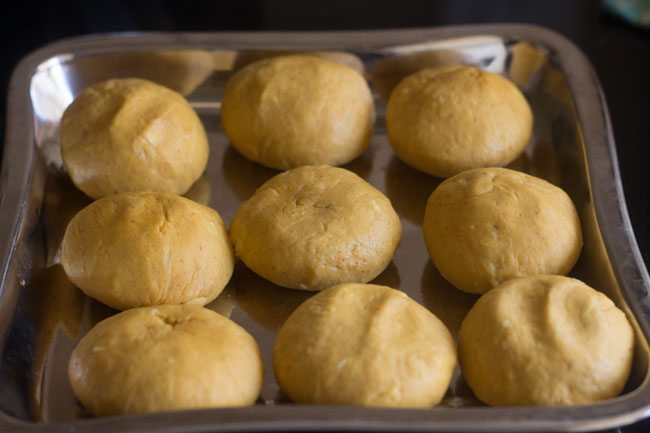
Assemble & Roll
12. Dust some flour on the rolling board and the dough ball.
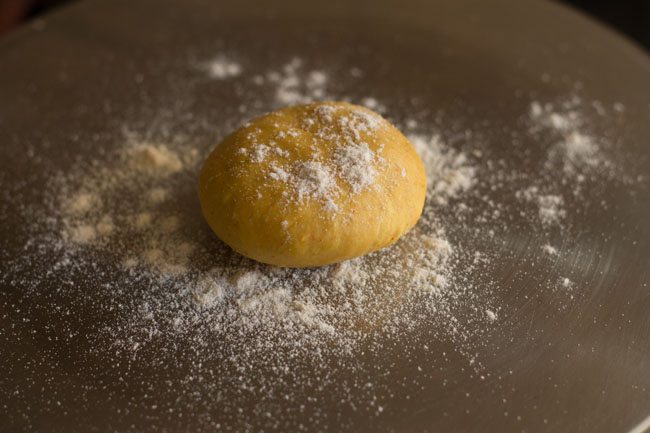
13. Gently flatten and roll with a pin roller first. Then, sprinkle some more flour, if required and roll to a disc, about 5 to 7 inches in diameter.
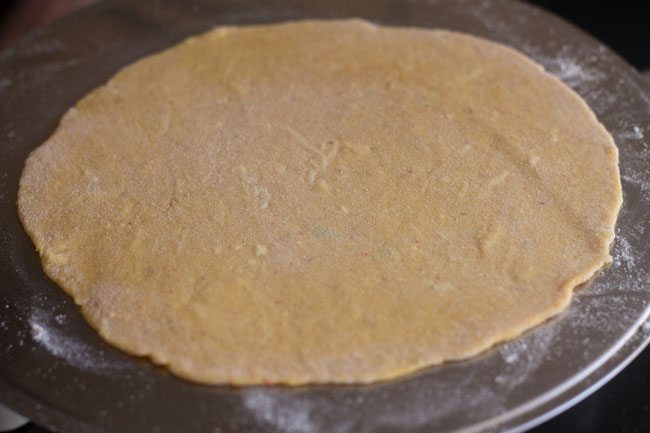
Roast Mooli Thepla
14. Heat a tawa or flat skillet. Place the rolled dough on it and keep the heat to medium to medium-high.
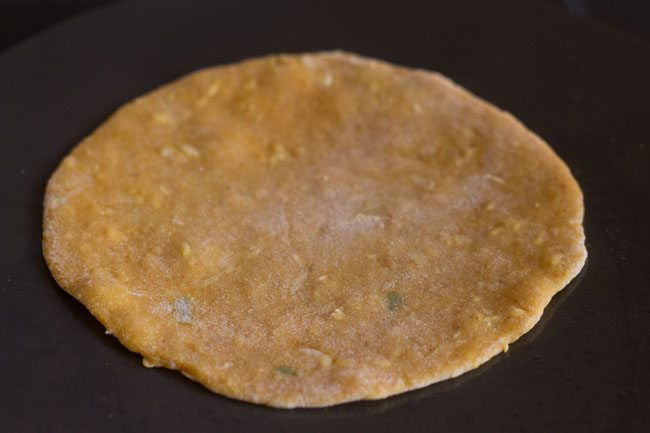
15. Roast until you see faint air pockets on it.
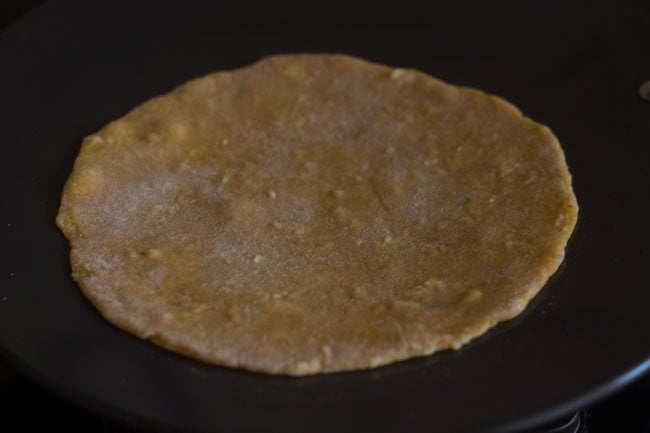
16. Then, flip using a spatula or tongs.
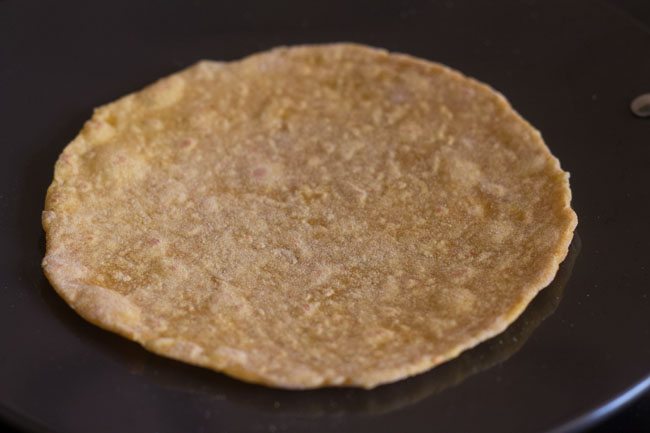
17. Spread some oil or ghee all over, according to your preferences.
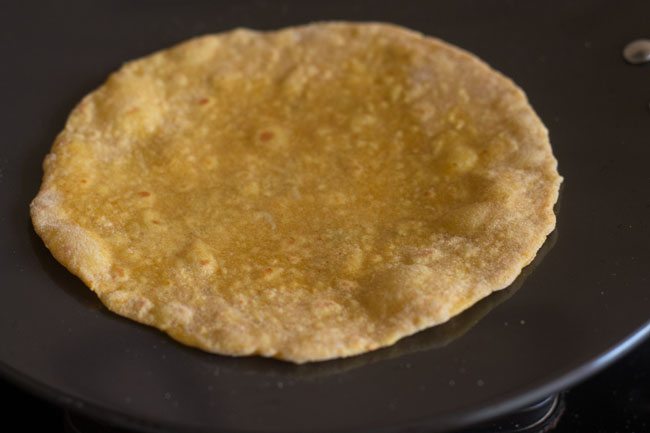
18. Flip again.
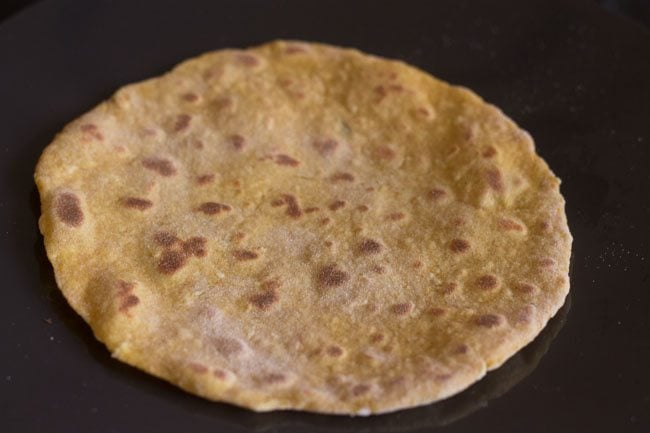
19. Spread oil or ghee on this side too.
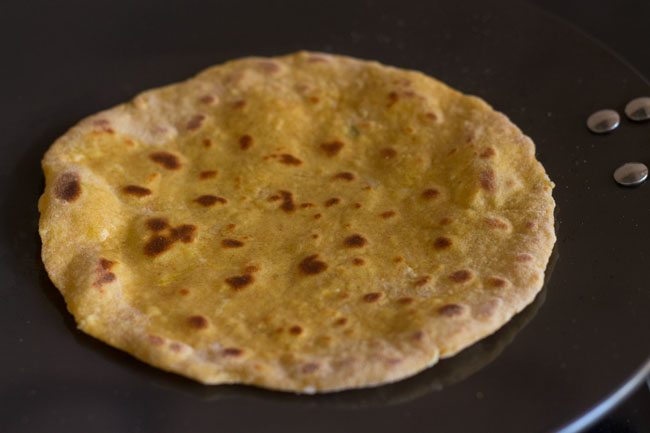
20. Flip once or twice, and until cooked well. Press the edges with the spatula so that the thepla is cooked evenly.
Similarly, make all the flatbreads in this manner. If you are making them to pack in tiffin boxes or for picnics, then spread some more oil, so that they stay soft.
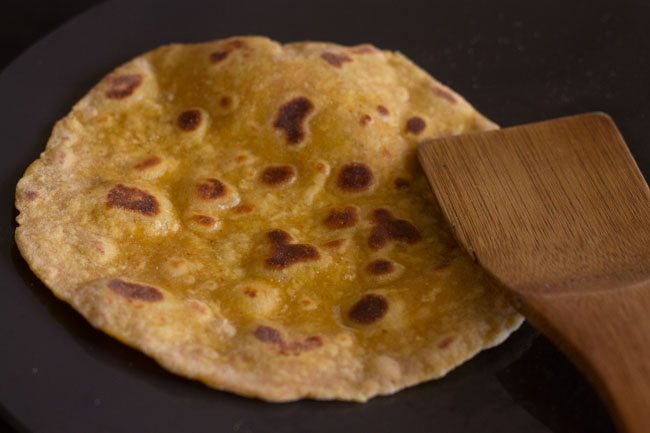
21. Serve Mooli Thepla hot, warm or at room temperature with a pickle, curd, aam chunda or mango chutney.
You can have them for breakfast, brunch or as a tea-time evening snack.
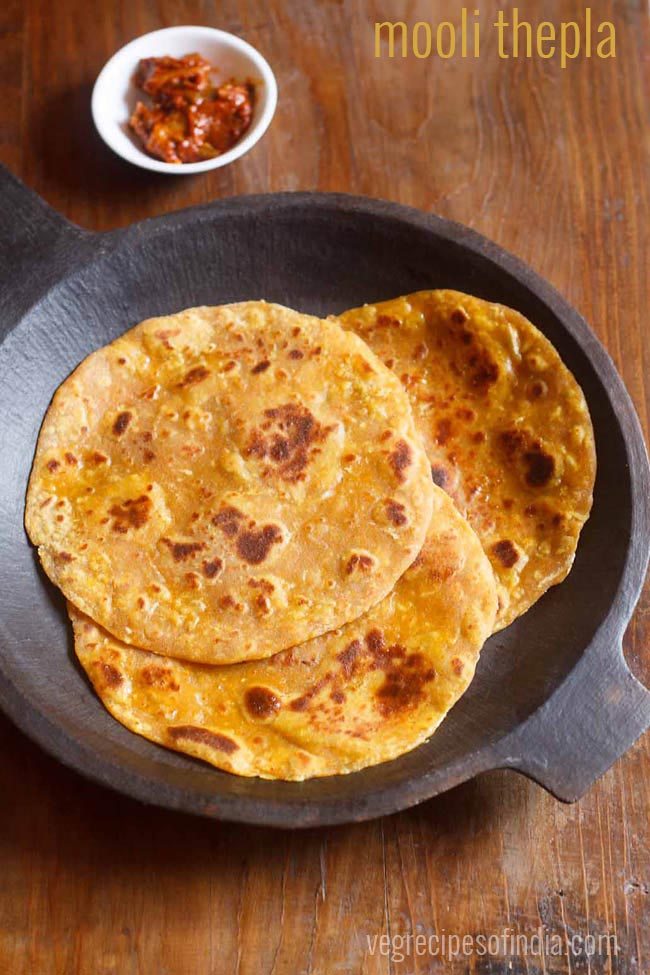
Expert Tips
- Radish: Mooli Thepla is usually made with white radish. Buy radish that is fresh and tender. Do not use radish that is hard, fibrous or stringy.
- Flour: You can skip adding gram flour (besan), if you do not prefer it. You can also add some healthy flours like pearl millet, finger millet (ragi) or sorghum flour.
- Curd (yogurt): When making this recipe, it is best to use fresh curd (yogurt), which is not sour. If yogurt is not available, add water or buttermilk as needed in the flour, to make a smooth and soft dough.
- Spicing: For a spicier taste, add more green chilies and red chili powder.
- Fats: You can roast the thepla with oil or ghee (clarified butter). Peanut oil also gives a good flavor. Although any neutral flavored oil can be used too.
- Scaling: This Mooli Thepla recipe can easily be reduced or scaled to make a small or big batch.
More Healthy Indian Flatbreads To Try!
Breakfast Recipes
Breakfast Recipes
Breakfast Recipes
Indian Breads
Please be sure to rate the recipe in the recipe card or leave a comment below if you have made it. For more vegetarian inspirations, Sign Up for my emails or follow me on Instagram, Youtube, Facebook, Pinterest or Twitter.
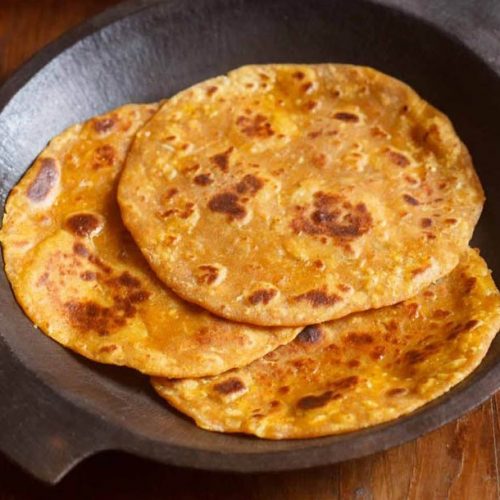
Mooli Thepla
Ingredients
- ¾ to 1 cup radish – grated, (white radish or mooli)
- 1.5 cups whole wheat flour
- 2 tablespoons gram flour (besan) – optional, can sub chickpea flour
- 1 to 2 tablespoon Curd (yogurt) – add 1 to 2 tablespoon more, if required while kneading the dough
- 1 small green chili – crushed to a paste in mortar pestle
- 1 inch ginger – peeled & crushed to a paste in mortar pestle
- ½ teaspoon Coriander Powder
- ½ teaspoon cumin powder
- ½ teaspoon red chili powder
- ¼ teaspoon turmeric powder
- 1 tablespoon oil or ghee
- ¾ teaspoon salt or as required
- oil as required, for roasting
Instructions
Kneading dough
- Rinse, peel and grate the radish in a bowl or plate. Grate about ¾ cup to 1 cup radish.
- Measure and keep all the ingredients ready.
- Add grated radish in a parat or big plate. Add all the spice powders, salt and ginger-chili paste.
- Next add coriander powder, cumin powder, red chili powder, turmeric powder, ginger-green chili paste and ¾ teaspoon salt or as required.
- Mix the spices very well with a spoon.
- Keep covered aside for 5 minutes. Soon the radish will release its juices.
- Then add the whole wheat flour and besan (gram flour). Adding gram flour is optional and can be skipped.
- Mix well with your fingertips.
- Add 1 to 2 tablespoon yogurt (curd or dahi) and 1 tablespoon oil.
- Mix well and begin to knead the dough.
- Make a smooth soft dough.
- Cover the dough with a plate or cotton napkin. Allow the dough to rest for 5 to 6 minutes.
- Again lightly knead the dough for a minute.
Rolling dough
- Make medium sized balls from the dough. Cover with a cotton napkin or lid.
- Dust some flour on the rolling board as well as the dough ball.
- Gently flatten with a rolling pin.
- Sprinkle some more flour if required.
- Roll to a round shape about 5 to 7 inches in diameter.
Roasting
- Place the rolled dough on a hot tawa or skillet. Keep the heat to medium to medium high.
- When you see faint blisters on them then flip.
- Spread some oil or ghee all over on this side and flip again.
- Spread oil or ghee on this side too.
- Flip them once or twice until they are cooked well. Make sure that the edges are also cooked well.
- Make all the flatbreads in this manner.
- If you are making them to carry for tiffin or picnics then spread some more oil, so that they stay soft.
- Serve these warm or at room temperature with pickle or curd (yogurt).
- You can also enjoy them as an evening tea time snack.
Notes
- To get the green chilli paste, crush both the peeled ginger and green chili in a mortar-pestle. You could also use ready 1 teaspoon ginger-green chili paste instead.
- Use tender and juicy white radish. Avoid using radish that is stringy or fibrous.
Nutrition Info (Approximate Values)
This Mooli Thepla recipe was first published on February 2017. It has been updated and republished on April 2024.
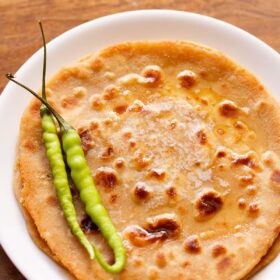
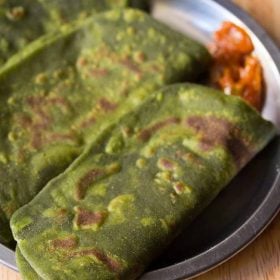
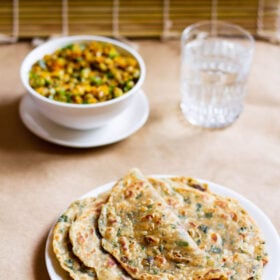
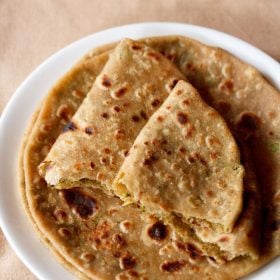
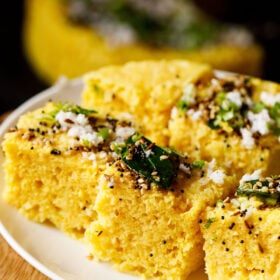
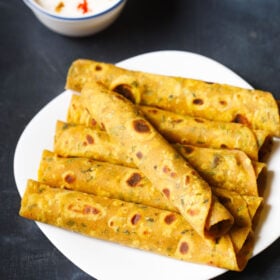
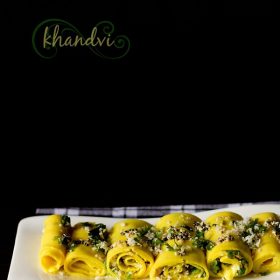
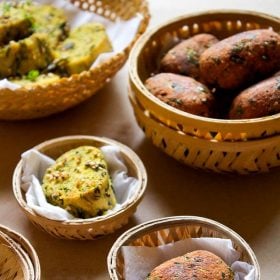








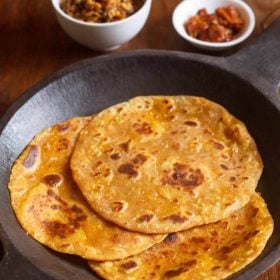
When I ate it immediately after making it I loved it. But my husband had it after a couple of hours and he found it kachcha.
Anything I can do differently next time? Can we roast the thepla a little more? Won’t it become hard?
Also, can we substitute Besan with sattu?
hi shruthi, thepla should be always roasted on a hot tawa. if the tawa is not hot enough, the thepla will not cook well. if the thepla is cooked properly, there won’t be any raw taste in it. cook on a medium-high to high flame. you should see charred spots or blisters on the thepla. press the thepla (center, edges etc) with a spatula while cooking, so that it roasted well. you can roast thepla for some more time if you see that they are not roasted well but do not too much as then they will become hard. you can use sattu flour instead of besan.